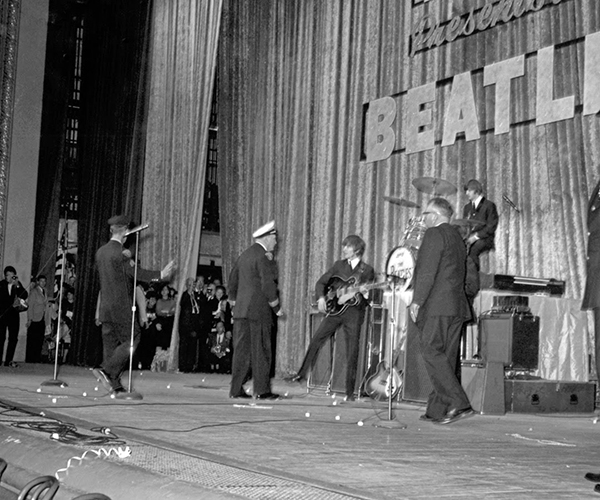Cleveland's twirl in the national spotlight this year revealed a startling truth: America is tired of making fun of us.
People are rooting for us. They want LeBron James' homecoming to end happily. Their sympathies go out to us for the decades of suffering and cruel fate — in sports and in weightier matters.
Which is nice. But confusing.
If we're not a laughingstock, if we abandon our defensiveness, who the heck are we?
To figure that out, don't we have to consider something even scarier? That maybe, just maybe, this is the era when — finally — everything that looks good doesn't go dreadfully, operatically wrong?
Can't we allow the possibility that our mumbled expectations of future disaster are self-fulfilling prophecies or at least a lousy way to live life?
Seeking answers and permission to think differently, I went to the southeast corner of East Ninth Street and Euclid Avenue. For more than 150 years, the corner has encapsulated this city and its shifting fortunes.
Between the Civil War and the 1905 groundbreaking for the Cleveland Trust rotunda on this spot, the city's population grew eightfold. Most newcomers were European immigrants. A teeming black neighborhood grew south of Public Square. Just down Euclid Avenue — visible from here — was Millionaires' Row, home to new-money tycoons and their lavish mansions: the richest road in America.
Here and then, anything was possible.
Cleveland Trust Co. bought the property in 1901. The bank, in business only seven years, had grown to holdings of almost $170 billion (in 2014 dollars). The palatial Cleveland Trust rotunda, though private then, would be built in the style of the country's progressive City Beautiful movement.
By the time construction on the rotunda was complete, Cleveland Trust had become America's sixth-richest bank and Cleveland the sixth-biggest city. Each enjoyed another half-century of prosperity, until the mid-'60s, when things went haywire.
As Cleveland Trust focused on growth in the suburbs and other cities, the downtown around its headquarters was being eaten away by neglect. The bank's relationship with the town and its rising bond debt grew increasingly rancorous.
Yet Cleveland Trust doubled down on its investment at Ninth and Euclid. The bank commissioned one of the century's great architects, modernist Marcel Breuer, to design its new headquarters.
The tower, which opened in 1971, was revered in architecture-nerd circles as the only Breuer skyscraper ever built. But it was kind of a disaster — like seemingly everything else in 1970s Cleveland. Flanking that old, beloved Beaux Arts dome was a spare, jarring, 29-story brutalist honeycomb. It was hard for the untrained eye to understand, much less love.
Plans to build an identical tower next door on Euclid were abandoned, sparing the pleasantly stolid 13-story, 1910 Swetland Building but creating an ungainly mishmash of warring styles.
In 1978, Cleveland Trust betrayed its very name. It thuggishly tried to strong-arm the city into selling Muny Light. When that failed, the bank forced Cleveland into default — the first major city to go broke since the
Great Depression.
The following year, the bank dropped "Cleveland" from its name and became Ameritrust.
In the '80s, the buildings on this corner were falling apart, even the Breuer tower. Same goes for Euclid in general and for Ameritrust, reeling from overexpansion and high-risk real estate loans.
Cleveland's 1990s comeback, viewed from this angle, was a cruel tease. Right up Ninth rose Jacobs Field, and next to it, Gund Arena (named after the son of George Gund, Cleveland Trust's midcentury president). Meanwhile, Ameritrust merged with another bank and shuttered the tower and rotunda. Which is how the buildings stayed for 18 years.
In 2005, Cuyahoga County bought them with an eye toward moving its offices to the corner. It spent the next few years bickering about demolition versus half-assed renovation, then garnished the debate with a corruption scandal.
But two or three years ago, it became possible to stand on this corner and think that finally, things might change for the better.
Blocks away, Playhouse Square was being transformed and East Fourth had become a phenomenon. The Avengers filmed on this very corner, raining down flaming vehicles, fake rubble and dollars galore. As the dust settled, you noticed that old buildings around here were becoming apartments and condos. Then you noticed a crew installing dog poop-bag dispensers. Once there's a need for these, you know people really live here.
Now, at Ninth and Euclid, it seems a miracle that the county unloaded these buildings only last year. The Swetland, rotunda and Breuer tower, restored and renovated, look like stylish, perhaps eccentric, members of a happily blended family. Dubbed The 9, this hotel, restaurant and apartment complex has apparently rented nearly all of its most expensive units. Its employees can live in modestly priced apartments in the Swetland.
The rotunda may be the most important puzzle piece. The former home of the sixth-biggest bank in America is being repurposed as a Heinen's. That's a comedown only if you forget that nobody goes to a bank anymore, but it's not a real urban neighborhood until a person can get to the grocery store just fine without a car.
Maybe this won't work out. Maybe downtown living never really blossoms for lack of good public schools. God knows, maybe all those hotels will struggle after the Republicans come and go. Maybe that huge, wacky chandelier at Playhouse Square won't ever become a beloved landmark. And maybe LeBron James' homecoming will befall unforeseen misfortune.
Maybe it all goes dreadfully wrong once again.
Yet here, at Ninth and Euclid, you can see the distant era when busy, ambitious Clevelanders greeted good fortune without steeling themselves for heartbreak. We were those people a lot longer than we've been fatalistic, afflicted sad sacks. Today, as I behold what's right before my eyes, it's easy to wonder if our old, optimistic ways were really so laughable.



